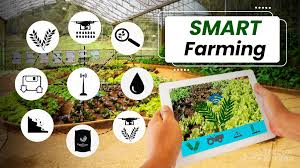India’s shrinking agricultural acreage is a problem with 9.1 billion people by 2050. Technology improves efficiency, productivity, and sustainability in precision agriculture or smart farming…
9.1 billion people are expected by 2050. India should contribute 1.5 billion. India will have 16.4% of the world’s population by 2050. As urbanization, industrialization, and climate change reduce agricultural land, India is in trouble. Food security and sustainable development are threatened by population growth and land scarcity. In 2021, India had 36.4 million hectares of arable land, less than 10% of its total area. That dropped from 45.4 million hectares in 1981. As its population grows, India must produce enough food despite shrinking agricultural land.
Fortunately, digital technology may fix this. With more access, agriculture’s technology barrier is falling. Cloud computing, AI-driven systems, open-source software, and other digital tools are transforming farming thanks to connectivity improvements. Like many nations, India is slowly adopting this transformative trend to improve food production and consumption. For India’s food security and economic stability, smart agricultural practices must be adopted faster.
Smart farming uses and benefits
Modern technology and traditional farming methods improve efficiency, productivity, and sustainability in smart or precision agriculture. IoT sensors, AI, data analytics, and robotics help farmers monitor soil conditions and other vital factors in real time. AI and data analytics inform crop and livestock management with this data. Data helps farmers optimize irrigation, fertilization, pest control, and resource allocation. Bots automate tasks and reduce labor. A crowded world with limited arable land requires smart farming to feed a growing population.
Smart agriculture is changing farming worldwide. According to a World Bank study, smart farming technologies can increase crop yields by 30%, reduce water use by 50%, and fertilizer use by 20%. FAO estimates smart agriculture can boost farm incomes by 25%. Farmers, investors, and consumers benefit from smart agriculture’s efficiency, sustainability, and productivit
Resource efficiency is a major benefit of smart farming. Precision water, fertilizer, and pesticide use saves farmers money, waste, and the environment.
Smart farming lets farmers monitor crops for stress, disease, and nutrient deficiency. This improves crop yields and quality.
Livestock and crops are monitored in smart agriculture. Wearable sensors and devices help farmers monitor livestock health, location, breeding, and well-being.
Smart farming helps farmers protect crops and livestock by predicting weather and extreme events.
Smart farming’s long-term financial benefits outweigh the setup cost, with increased productivity and decreased waste.
Smart farming issues in India
Smart farming has many benefits, so India is promoting it. BIS Research expects state initiatives like the Digital Agriculture Mission 2021-2025 to grow the Indian Smart Farming Market from $306.53 million in 2021 to $834.94 million in 2027 (CAGR 17.98%). Artificial intelligence, blockchain, remote sensing, GIS, drones, and robots are encouraged. The Kerala Vertical Garden Scheme is expected to boost indoor farming technology to $217 million by 2027 (CAGR 29.31%). Microfinance promotes financial inclusion in the Indian Precision Agriculture Market, which is expected to reach $337.7 million by 2027 (CAGR 17.18%) from $132.1 million in 2021.
But this is insufficient. India has 157.35 million hectares of farmland and 145 million farms, but only 6 million are digitally integrated. Agriculture supports 95 million Indian salaried workers, but smart farming is difficult:
Small farmers who barely make a living cannot afford smart agriculture technologies.
A stable internet connection is essential for smart agriculture, but most rural areas in India lack it.
Ignorance and technological literacy: Rural Indian farmers struggle to adopt modern farming technologies.
Smart farming requires data privacy and cybersecurity assurances from farmers.
Urgent need
Challenges are surmountable. India needs smart farming. Through government support, private partnerships, awareness campaigns, and technological investments, Indian agriculture can become more productive, eco-friendly, and economically viable to ensure a more food-secure and sustainable future for India and the world.
Conclusion
By 2050, India will have 9.1 billion people, and urbanization, industrialization, and climate change threaten food security and sustainable development. Indian farming is becoming smarter with cloud computing, AI, and open-source software. Modern and traditional farming methods are combined in this technology to boost efficiency, productivity, and sustainability. By collecting real-time soil data, IoT, AI, data analytics, and robotics help farmers optimize irrigation, fertilization, pest control, and resource allocation. Bots boost productivity and reduce manual labor.
Smart farming technologies can increase crop yields by 30%, reduce water use by 50%, and fertilizer use by 20%. The FAO estimates smart agriculture can boost farm incomes 25%. The government prioritizes the Indian Smart Farming Market, which is expected to grow. Infrastructure, affordability, rural farmer awareness, data privacy, and security remain issues.



